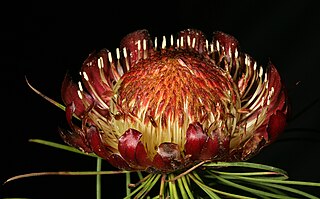
Andrew Geddes Bain, was a Cape Colony geologist, road engineer, palaeontologist and explorer.

The Karoo is a semi-desert natural region of South Africa. No exact definition of what constitutes the Karoo is available, so its extent is also not precisely defined. The Karoo is partly defined by its topography, geology and climate, and above all, its low rainfall, arid air, cloudless skies, and extremes of heat and cold. The Karoo also hosted a well-preserved ecosystem hundreds of million years ago which is now represented by many fossils.

Witzenberg Municipality is a local municipality located within the Cape Winelands District Municipality, in the Western Cape province of South Africa. As of 2022 it had a population of 103,765.

The Breede River, also known as Breë River, is a river in the Western Cape Province of South Africa. Travelling inland north from the city of Cape Town, the river runs in a west to east direction. The surrounding western mountains formed the first continental divide experienced by European settlers in the 18th century. The Witels River and Dwars River become the Breë River.

Protea laurifolia, also known as the grey-leaf sugarbush, is a shrub from South Africa. It is native to the Cape Provinces of South Africa.
Chrysoritis adonis, the Adonis opal, is a species of butterfly in the family Lycaenidae. It is endemic to South Africa, where it is found on the northern slopes of the Gydoberg, the Skurweberg, the Baviaanskloofberg and the Waboomberg, as well as the Elandskloof near Seweweekspoort.

Thestor petra, the rock skolly, is a species of butterfly in the family Lycaenidae. It is endemic to South Africa.

Dinopithecus is an extinct genus of very large primates, closely related to baboons, that lived during the Pliocene and Pleistocene epochs in South Africa and Ethiopia. It was named by British paleontologist Robert Broom in 1937. The only species currently recognized is Dinopithecus ingens, as D. quadratirostris has been reassigned to the genus Soromandrillus. It is known from several infilled cave sites in South Africa, all of early Pleistocene age, including Skurweberg, Swartkrans, and Sterkfontein.
Thestor vansoni, the Van Son's skolly, is a butterfly of the family Lycaenidae. It is found in South Africa, where it is found in the Nama Karoo just below the peaks of the Gydoberg, the Skurweberg and the Cederberg in the Western Cape.

The San, or Bushmen, are indigenous people in Southern Africa particularly in what is now South Africa and Botswana. Their ancient rock paintings and carvings are found in caves and on rock shelters. The artwork depicts non-human beings, hunters, and half-human half-animal hybrids. The half-human hybrids are believed to be medicine men or healers involved in a healing dance. Gall writes, "The Laurens van der Post panel at Tsodilo is one of the most famous rock paintings." High on this rock face in Botswana is the image of a "magnificent red eland bull" painted, according to Van der Post, "only as a Bushman who had a deep identification with the eland could have painted him." Also on this rock face is a female giraffe that is motionless, as if alarmed by a predator. Several other images of animals are depicted there, along with the flesh blood-red handprints that are the signature of the unknown artist. The Drakensberg and Lesotho are particularly well known for their San rock art. Tsodilo was recognised as a UNESCO World Heritage Site in 2001; not all the art covered by this is by San people or their ancestors.

Protea pityphylla, also known as Ceres sugarbush or mountain rose, is a flowering shrub of the genus Protea, in the family Proteaceae. The plant is endemic to the southwestern Cape Region of South Africa.
Dianthus bolusii, called the mountain pink or bergangelier, is a species of flowering plant in the family Caryophyllaceae.

Erica junonia is a plant that belongs to the genus Erica and is part of the fynbos. The species is endemic to the Western Cape and occurs in the Skurweberg in the Koue Bokkeveld near Ceres. The plant's habitat is threatened by the high incidence of wildfires, droughts and invasive plants.









